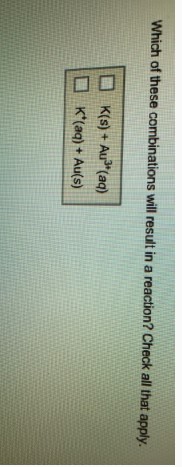QQuestionAnatomy and Physiology
QuestionAnatomy and Physiology
Which of these combinations will result in a reaction? Check all that apply.
| $\square$ | $\mathrm{K}(\mathrm{s})+\mathrm{Au}^{3 +}(\mathrm{aq})$ |
| --- | --- |
| $\square$ | $\mathrm{K}^{+}(\mathrm{aq})+\mathrm{Au}(\mathrm{s})$ |
Attachments

6 months agoReport content
Answer
Full Solution Locked
Sign in to view the complete step-by-step solution and unlock all study resources.
Step 1: Identify the given half-reactions and their corresponding reduction potentials.
The first half-reaction is: \mathrm{K}(\mathrm{s}) \longrightarrow \mathrm{K}^{+}(\mathrm{aq}) + e^{-} \qquad E^{\circ} = - 2.93 \ \mathrm{V} The second half-reaction is: \mathrm{Au}^{3 +}(\mathrm{aq}) + 3 \ e^{-} \longrightarrow \mathrm{Au}(\mathrm{s}) \qquad E^{\circ} = 1.50 \ \mathrm{V}
Step 2: Multiply the number of electrons in each half-reaction by an integer so that the number of electrons is equal in both half-reactions.
In this case, we need to multiply the first half-reaction by 3 and the second half-reaction by 1. First half-reaction multiplied by 3: 3 \ \mathrm{K}(\mathrm{s}) \longrightarrow 3 \ \mathrm{K}^{+}(\mathrm{aq}) + 3 \ e^{-} \qquad E^{\circ} = - 2.93 \ \mathrm{V} Second half-reaction multiplied by 1: \mathrm{Au}^{3 +}(\mathrm{aq}) + 3 \ e^{-} \longrightarrow \mathrm{Au}(\mathrm{s}) \qquad E^{\circ} = 1.50 \ \mathrm{V}
Final Answer
The reaction between $\mathrm{K}(\mathrm{s})$ and $\mathrm{Au}^{3 +}(\mathrm{aq})$ will result in a reaction. The balanced reaction is: 3 \ \mathrm{K}(\mathrm{s}) + \mathrm{Au}^{3 +}(\mathrm{aq}) \longrightarrow 3 \ \mathrm{K}^{+}(\mathrm{aq}) + \mathrm{Au}(\mathrm{s})
Need Help with Homework?
Stuck on a difficult problem? We've got you covered:
- Post your question or upload an image
- Get instant step-by-step solutions
- Learn from our AI and community of students